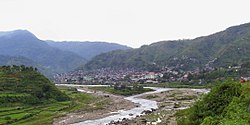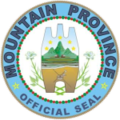Top Qs
Timeline
Chat
Perspective
Mountain Province
Province in Cordillera, Philippines From Wikipedia, the free encyclopedia
Remove ads
Mountain Province (Bontok: Probinsiya nan Bilig; Balangao: Probinsiya hen Bilig; Kankanaey: Probinsiya di Dontog; Ilocano: Probinsia ti Bantay; Tagalog: Lalawigang Bulubundukin;[3] Spanish: Provincia Montañosa) is a landlocked province of the Philippines in the Cordillera Administrative Region in Luzon. Its capital is Bontoc while Bauko is the largest municipality. Mountain Province was formerly referred to as Mountain in some foreign references. The name is usually shortened by locals to Mt. Province.
The province was named so for being in the Cordillera Central mountain range found in the upper realms of Luzon island.
Mountain Province was also the name of the historical province that included most of the current Cordillera provinces. This old province was established by the Philippine Commission in 1908,[4][5][6] and was later split in 1966 into Mountain Province, Benguet, Kalinga-Apayao and Ifugao.[7][8][9]
The province is also known for its mummy caves, which contain naturally mummified bodies, and for its hanging coffins.[7]
Remove ads
History
Summarize
Perspective
Spanish colonial era
The area of the Cordillera mountains proved difficult to control by the Spaniards. During the long Spanish rule, not much was done to bring the province under control. From 1566 to 1665, they sent expeditions to conquer the land but the rugged terrain and hostile indigenous population at the time were major obstacles to complete subjugation.[10] The first serious effort to subjugate them was made in 1785 when soldiers were sent from Cagayan to put down a revolt of the Kalingas. A famous Spanish explorer, Guillermo Galvez, conducted more than 40 forays to the mountainous region.[11]
Formerly called La Montañosa by the Spanish colonizers due to its mountainous terrain,[7][12] the area was subdivided into 6 comandancias politico-militar.[13]
American colonial era
Bontoc sub-province in 1918, which roughly covers the territory of modern day Mountain province
On August 19, 1908, during the American rule, the Philippine Commission enacted Act No. 1876, which organized the entire area of the Cordilleras into one large province, named Mountain Province.[4][6][7][14]
The first governor was Samuel Kane, and the town of Bontoc was made the capital. It was originally composed of the sub-provinces of Amburayan, Apayao, Benguet, Lepanto-Bontoc, Ifugao and Kalinga.[6][12] Amburayan was later abolished in 1920 and its corresponding territories were transferred to the provinces of Ilocos Sur and La Union. Lepanto was also reduced in size and its towns were integrated into the sub-provinces of Bontoc and Benguet, and to the province of Ilocos Sur.[10][15] [16]
Philippine independence
Effective on April 7, 1967, Republic Act No. 4695 abolished the old Mountain Province, converting its sub-provinces into 4 independent provinces: Benguet, Ifugao, Kalinga-Apayao and Mountain Province (corresponding to the former Bontoc sub-province).[7] Bontoc became the capital of the new Mountain Province.[9][12]
Mountain Province would have been significantly affected by the Chico River Dam Project during the Marcos administration, as the Marcos regime's project would have flooded the municipalities of Sabangan, Sagada, Sadanga, Bontoc, Bauko, and parts of Barlig.[17] However, the indigenous peoples of Kalinga Province and Mountain Province resisted the project and when hostilities resulted in the murder of Macli-ing Dulag, the project became unpopular and was abandoned before Marcos was ousted by the 1986 People Power Revolution.[18]
On June 15, 1987, the Cordillera Administrative Region was established upon the issuance of Executive Order 220 by then-President Corazon Aquino, and Mountain Province was made one of its provinces.[10][19][20]
Indigenous People's Day
Through Presidential Proclamation 682, October 4, 2024 was declared a special non-working day to commemorate the Provincial Indigenous People’s Day.[21]
Remove ads
Geography
Summarize
Perspective
Mountain Province covers a total area of 2,157.38 square kilometers (832.97 sq mi)[22] occupying the central section of the Cordillera Administrative Region in Luzon. The province is bordered on the north by Kalinga, east by Isabela, south by Ifugao, southwest by Benguet, west by Ilocos Sur, and northwest by Abra.
Situated within the Cordillera Central, Mountain Province is 83% mountainous while 17% make up hills and levels. The province has many rivers, waterfalls, mountains, and caves. The central and western areas of the province are characterized by rugged mountains and steep cliffs, while the eastern portion has generally sloping terrain.[7][12]
Administrative divisions
Mountain Province comprises ten municipalities, all encompassed by a lone legislative district.[22]

Barangays
Mountain Province has 144 barangays comprising its 10 municipalities.[24]
As of 2010, the most populous barangay in the province is Poblacion in the municipality of Paracelis, with a total of 5,687 inhabitants. Balintaugan in the municipality of Bauko has the least population with only 144.[24]
Remove ads
Demographics
Summarize
Perspective
The population of Mountain Province in the 2020 census was 158,200 people,[2] with a density of 73 inhabitants per square kilometre or 190 inhabitants per square mile.
Based on the 2000 census survey, Kankana-ey comprised 51.8% (72,694) of the total provincial population of 140,339. Balangao/Baliwon came in second at 13.46% (18,886), and Bontoc at 12.28% (17,234). Other ethnicities were the Ilocano at 4.97% (6,968), Applai at 2.1% (2,947), Binontok at 1.79% (2,510), and Kalinga at 1.76% (2,468).[26]
Languages
The main languages of Mountain Province are Kankanaey and Bontoc. Ilocano is used as a lingua franca in the province and is widely spoken and understood by the residents.
Religion
Catholicism

Anglicanism predominates in the province with approximately 60% adherence to other religions such as Roman Catholicism.[citation needed]
Others
Other groups include Members Church of God International (MCGI), Seventh-Day Adventist Church, Iglesia Filipina Indepiendente, Iglesia ni Cristo has 3% of the Listing Members in the province and Free Believers in Christ Fellowship. Mountain Province is the only predominantly Protestant province in the Philippines.
Remove ads
Economy
Poverty incidence of Mountain Province
10
20
30
40
50
60
2000
12.28 2003
57.00 2006
44.07 2009
52.16 2012
37.63 2015
44.70 2018
24.58 2021
15.30 Source: Philippine Statistics Authority[27][28][29][30][31][32][33][34] |
Tourism
The province has several rice terraces in seven of its different towns:[12]
- Ambasing Rice Terraces — Sagada
- Bangaan Rice Terraces — Sagada
- Bangen Rice Terraces — Bauko
- Barlig Rice Terraces — Barlig
- Bayyo Rice Terraces — Bontoc
- Besao Rice Terraces — Besao
- Bontoc Poblacion Rice Terraces — Bontoc
- Bucas Rice Terraces — Besao
- Bulongan Rice Terraces — Sagada
- Dalican Rice Terraces — Bontoc
- Fidelisan Rice Terraces — Sagada
- Focong Rice Terraces — Sadanga
- Kapayawan Rice Terraces — Bauko
- Kiltepan Rice Terraces — Sagada
- Maligcong Rice Terraces — Bontoc
- Natonin Rice Terraces — Natonin
- Sadanga Rice Terraces — Sadanga
- Suyo Rice Terraces — Sagada
- Tanulong Rice Terraces — Sagada
The mountainous province also offers excellent mountain climbing experiences with two of its mountains among the top 10 highest points in the Philippines:
- Mount Kalawitan, 2,714+msl - Sabangan
- Mount Amuyao or Mount Finaroy, 2,702+msl - Barlig
Remove ads
Government
List of recent governors
- 2001–2004 — Sario M. Malinias
- 2004–2010 — Maximo B. Dalog
- 2010–2016 — Leonard G. Mayaen
- 2016–present — Bonifacio C. Lacwasan Jr.
Notable people
- Jeyrick Sigmaton - actor and model[35]
- Marky Cielo - actor
- Francisco Claver - Roman Catholic bishop, Jesuit, and human rights activist
- Eduardo Masferré - Filipino-Catalan photographer regarded as the Father of Philippine photography.[36]
- William Henry Scott - Historian and Episcopalian missionary best known for numerous books on the Cordilleran peoples and on Precolonial Philippines.[37]
References
External links
Wikiwand - on
Seamless Wikipedia browsing. On steroids.
Remove ads













